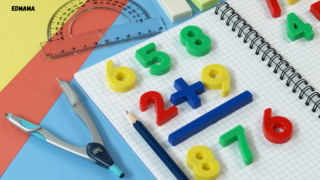
Course Content
A. Comparing Quantities
-
A.01. Identify if there are enough objects in a set to match a given number.
-
A.02. Discriminate between sets with ‘more’ and ‘fewer’ objects.
-
A.03. Compare two groups by counting to determine which has more or fewer objects.
-
A.04. Compare objects in a mixed group using terms like “more,” “fewer,” and “same.”
-
A.05. Determine if two sets have the same number of objects.
-
A.06. Arrange groups of objects from least to most based on quantity.
-
A.07. Create sets with a specified number of objects to match a given quantity.
B. Positions and Spatial Awareness
-
B.01. Identify objects that are inside or outside of a container or boundary.
-
B.02. Describe the position of objects as above or below another object.
-
B.03. Describe the position of objects as beside or next to another object.
-
B.04. Differentiate between left and right from a personal perspective.
-
B.05. Identify the left, middle, and right positions in a sequence of objects.
-
B.06. Identify the top and bottom positions of objects in a vertical arrangement.
-
B.07. Identify the top, middle, and bottom positions of objects in a vertical arrangement.
-
B.08. Follow multi-step directions involving positional words.
-
B.09. Draw objects in specific positions relative to other objects.
C. Classifying Objects
-
C.05. Classify and sort objects based on colour.
-
C.06. Classify and sort objects based on shape.
-
C.07. Classify and sort objects based on size.
-
C.08. Explain the reasoning behind a chosen classification method.
-
C.01. Recognize when two objects are the ‘same’.
-
C.02. Recognize when two objects are ‘different’.
-
C.03. Distinguish between objects that are the same and different.
-
C.04. Classify shapes based on colour.
D. Size and Measurement
-
D.01. Identify objects that are long and short.
-
D.02. Identify objects that are tall and short.
-
D.03. Identify objects that are wide and narrow.
-
D.04. Identify objects that are light and heavy.
-
D.05. Determine which container holds more or less.
-
D.06. Compare objects based on size, weight, and capacity.
-
D.07. Use non-standard units to measure the length or height of objects.
-
D.08. Explain how different units of measurement affect the numerical result.
E. Money Recognition
-
E.01. Recognize and identify the value of 1c, 2c, 5c, and 10c coins.
-
E.02. Recognize and identify the value of 20c, 50c, €1, and €2 coins.
-
E.03. Recognize and identify the value of all euro coins.
-
E.04. Count a collection of 1c coins.
-
E.05. Determine the total value of a small group of mixed coins.
-
E.06. Solve simple word problems involving the value of coins.
F. Flat Shapes
-
F.01. Identify and name common flat shapes (circle, square, triangle, rectangle).
-
F.02. Recognize and identify circles.
-
F.03. Recognize and identify squares.
-
F.04. Recognize and identify triangles.
-
F.05. Recognize and identify rectangles.
-
F.06. Differentiate between circles, squares, and triangles.
-
F.07. Describe the attributes of different flat shapes (e.g., number of sides, corners).
-
F.08. Create drawings and designs using various flat shapes.
G. Solid Shapes
-
G.01. Distinguish between flat and solid (3D) shapes.
-
G.02. Name common solid shapes (sphere, cube, cone, cylinder).
-
G.03. Recognize and identify spheres.
-
G.04. Recognize and identify cubes.
-
G.05. Recognize and identify cones.
-
G.06. Recognize and identify cylinders.
-
G.07. Select solid shapes based on a given description.
-
G.08. Relate solid shapes to everyday objects.
-
G.09. Compare and contrast properties of different solid shapes (e.g., can roll, can stack).
H. Count to 3
-
H.01. Learn to count up to 3.
-
H.02. Count a group of objects up to 3.
-
H.03. Count dots arranged in different patterns up to 3.
-
H.04. Count shapes up to 3.
-
H.05. Count on ten frames up to 3.
-
H.06. Show numbers on ten frames up to 3.
-
H.07. Represent numbers up to 3 using objects or drawings.
-
H.08. Recite the number sequence from 1 to 3.
I. Count to 5
-
I.01. Learn to count up to 5.
-
I.02. Count a group of objects up to 5.
-
I.03. Count dots arranged in different patterns up to 5.
-
I.04. Count shapes up to 5.
-
I.05. Count on ten frames up to 5.
-
I.06. Show numbers on ten frames up to 5.
-
I.07. Represent numbers up to 5 using objects or drawings.
-
I.08. Recite the number sequence from 1 to 5.
J. Count to 10
-
J.01. Learn to count up to 10.
-
J.02. Count a group of objects up to 10.
-
J.03. Count dots arranged in different patterns up to 10.
-
J.04. Count shapes up to 10.
-
J.05. Count on ten frames up to 10.
-
J.06. Show numbers on ten frames up to 10.
-
J.07. Represent numbers up to 10 using objects or drawings.
-
J.08. Recite the number sequence from 1 to 10.
K. Count to 20
-
K.01. Count a group of objects up to 20.
-
K.02. Count dots arranged in different patterns up to 20.
-
K.03. Count shapes up to 20.
-
K.04. Count on ten frames up to 20.
-
K.05. Show numbers on ten frames up to 20.
-
K.06. Represent numbers up to 20 using objects or drawings.
-
K.07. Recite the number sequence from 1 to 20.
-
K.08. Count backwards from 20 to 1.
L. Recognizing Patterns
-
L.01. Identify and extend colour patterns.
-
L.02. Identify and extend size patterns.
-
L.03. Identify and extend shape patterns.
-
L.04. Predict what comes next in a repeating pattern.
-
L.05. Create own colour patterns.
-
L.06. Create own size patterns.
-
L.07. Create own shape patterns.
-
L.08. Describe the rule governing a simple repeating pattern.